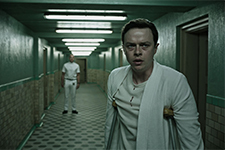A Cure for Wellness
|  I appreciate what Gore Verbinski was going for in A Cure for Wellness, his first directorial effort since the misguided disaster that was Disney’s The Lone Ranger (2013) nearly four years ago. Like Francis Ford Coppola did in Bram Stoker’s Dracula (1992) and Guillermo del Toro did more recently in Crimson Peak (2015), Verbinski is not only mining the narrative traits and signifiers of gothic and Victorian horror, but trying to evoke the overall feel of the genre’s roots. Although set in the present day (it opens with menacing low-angle shots of interchangeable glass skyscrapers), most of A Cure for Wellness takes place in a remote sanitarium at the foot of the Swiss Alps, where it might as well be 1817, not 2017. Verbinski captures not only the eerie, disorienting feel of isolation, but the gradual terror of losing one’s mind; he and cinematographer Bojan Bazelli (Pete’s Dragon, The Ring) also pick at our inherent fear of the medical professions and the spaces they occupy, with plenty of attention paid to clanking metal wheelchairs and crutches, old-fashioned therapy devices like steam baths and iron lungs, and the unseemly menace of endless expanses of glistening tile and sickly hospital-green paint. The film is, really, a visual marvel. It’s too bad, then, that it doesn’t work nearly so well on a narrative level. In fact, the screenplay by Justin Haythe (Revolutionary Road, The Lone Ranger) from a story he concocted with Verbinski is something of a mess, even though it starts from an intriguing premise and maintains a solid level of mystery and interest for at least half its running time. And, had the film been about half an hour shorter and minus a few climaxes, it might have really worked in a taut, tense kind of way. But, as is, it stretches out much too far, draining the tension it so eloquently built for its first hour and squandering its good will on a series of revelations that become all too obvious long before the curtain is cast aside. The film’s less-than-admirable protagonist is Lockhart (Dane DeHaan), a young and rapidly rising executive in an international finance firm who is tapped by his superiors to travel to Switzerland to retrieve from the aforementioned sanitarium another executive named Pembroke (Harry Groener). Pembroke went there for a restful vacation, but he hasn’t been seen for several weeks, and his only communication is a strange letter that suggests he has lost his mind. The firm needs his signature to complete a huge merger, and they have Lockhart in a bind: They know that he violated SEC rules to advance his career, and they promise him that if the deal doesn’t go down, he will. Lockhart’s highly motivated attempts to retrieve—or even see—Pembroke are met with resistance on every level once he reaches the sanitarium. The nurses are friendly in a strangely unfriendly kind of way, and the chief physician (Adrian Schiller) is reluctant to allow Lockhart to see Pembroke after visiting hours or to interrupt his treatment. After hearing from a mysterious wisp of a patient named Hannah (Mia Goth) that no one ever leaves the sanitarium, Lockhart is promptly caught up in a car accident that keeps him confined there with a broken leg. This, of course, gives him plenty of time to snoop, and the more corners he peeks around and the more doors he looks behind, the more he realizes that something deeply nefarious is going on and that all the rich, elderly men and women there are either dupes or accomplices. To reveal much more would spoil what unnerving pleasures the film has to offer, but suffice it to say that the sanitarium operates very much like the fabled castle in Gothic literature, a house built on various sins and transgressions that are sure to bring it down eventually. Like those old, crumbling Gothic castles, which stretch from the one in Horace Walpole’s defining 1764 novel The Castle of Otranto, to the titular manor in del Toro’s Crimson Peak, the sanitarium is a kind of physical embodiment of the horrors and perversities that are yet to be revealed, and A Cure for Wellnes deviates from the formula only in making the protagonist a man, rather than a woman (although one could argue that Hannah is as much a protagonist as Lockhart is, especially in the film’s second half). There are some genuinely fantastic sequences scattered throughout the film, and Verbinski, who broke through 15 years ago with his 2002 remake of the Japanese horror film The Ring, has an innate sense of what is quietly unnerving. He goes for menace and atmosphere, rather than cheap jump scares, and when the film works, it is quite malevolent in the best kind of way. Unfortunately, it simply goes on for too long, and what had been working at the beginning feels tired and strung out once we pass the two-hour mark. Sometimes you can have too much of a good thing. Copyright © 2017 James Kendrick Thoughts? E-mail James Kendrick All images copyright © 20th Century Fox |
Overall Rating: 

 (2.5)
(2.5)


